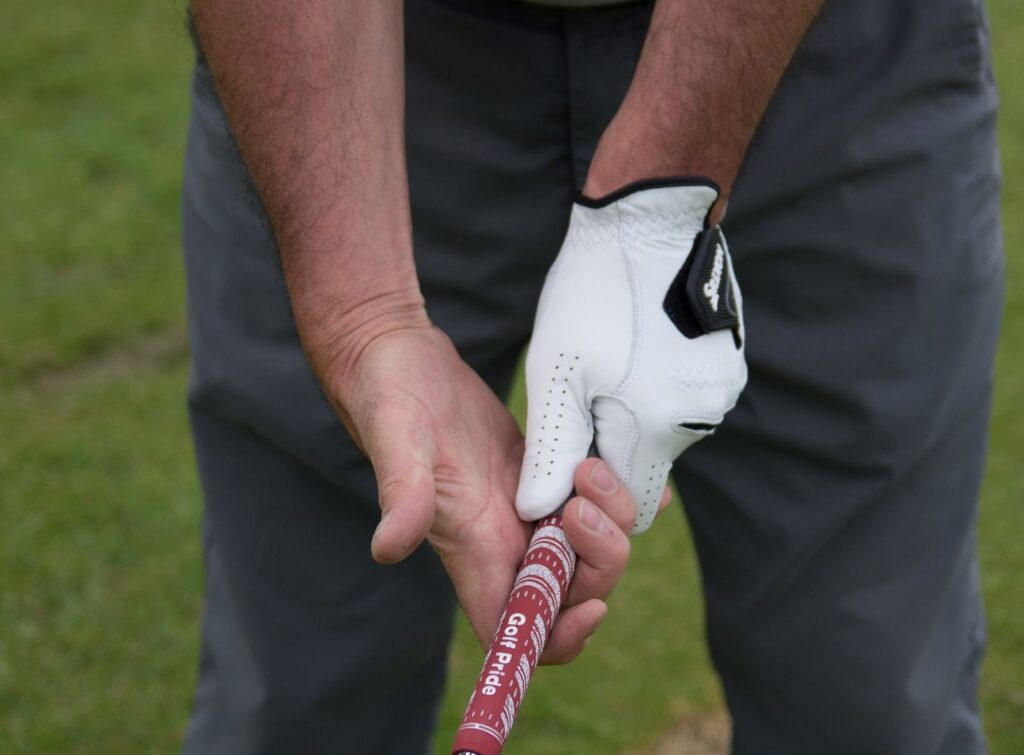Golf Swing Precision- It's All in Your Hands
Hold it Right – Without doubt, the golf grip is perhaps the single greatest, yet often overlooked, challenge faced by the casual golfer. Your grip is your only point of contact with the club and unless you get it right you will be sorely challenged to improve your game.
Yes! Proper Hand set-up is crucial for your golf swing. perfect grip for golf is something that allows you to produce a consistent impact that allows you to strike the golf ball consistently and get the desired ball flight that you want.
Grip can have a dramatic effect on the outcome of your golf swing i.e. where the golf ball goes, and is often the first port of call when addressing a hook or a slice. In a lot of cases just simply improving your grip can eliminate a hook or slice because it can help square up your club face at impact.
There isn’t a perfect grip for golf but there’s certain things that if you get right, it will help you grip the golf club and it makes it easier to get he right grip for your shot shape, or for the shot you are intending to play.
Grip doesn’t magically cure a swing plane problem but that is something that I will address in future articles.
First, decide which Grip Style suits you or “feels” right – In order of popularity, there are 3 common grip styles: Overlapping, Interlocking, and Ten Finger (a.k.a. the baseball grip).
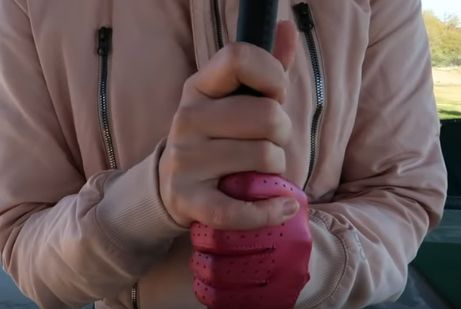
** In the overlapping grip, you place the little finger of your trailing hand between the index and second finger of your lead hand. Rest the lead hand thumb in the lifeline of the trailing hand.
** With the interlocking grip, hook the little finger of your trailing hand under and around the index finger on the lead hand. Tuck the lead hand thumb in the lifeline of the trailing hand.
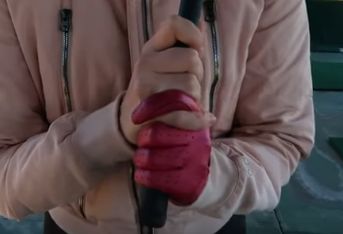
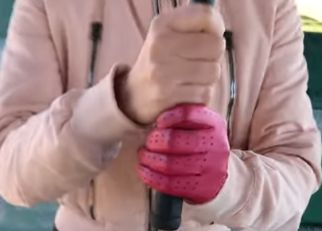
** The ten-finger grip is as it sounds, with 10 fingers in perfect contact with the handle. Grip the club with the lead hand and position your trailing hand so that
your little finger is right smack against the index finger of the lead hand. Tuck the lead hand thumb under the lifeline of the trailing hand.
This grip is often used by beginners as it “feels” more natural, but ideally should be avoided. Plus, you’ll have to change to one of the other two if you want your game to continually improve.
Once you have your hands in a grip that feels right you need to be aware of your grip position. That can either be strong, neutral, or weak.
What position you use may vary between your drivers and your irons and an intended shot shape you are trying to produce, but it will ultimately be determined by your natural shape shot.
Most amateur golfers that slice often have a weak grip. Those that hook, a strong grip. If you have a neutral grip what you do with your hands will be determined, again, by your shot shape.
Lets’ start with a neutral grip.
First and foremost you wan to make sure that the golf clubis straight. Such that the club face is perpendicular (90 Degrees ) to you target i.e. your club face is pointing at your target.

Start with your lead hand. That’s your left hand for a right-handed golfer. Grip the club low on the grips with your trail hand first and hold the club out in front of you with the toe pointing up so that the club face is aiming at, or perpendicular to, your target.
Hold your lead hand out as if you were to shake someone’s hand. And grip the top of the club. Let go with your trail hand. The handle should run along the creases of your fingers, such that if you release your middle, ring and pinkie fingers you should still be able to hold the club upright. The butt of the club held in place by the muscle ‘bump’ of your hand below your pinkie finger.

This will prevent you from gripping the club to high in your palm, and usually to firmly, as well as from having the club too upright and far away from your body (like a putter).
This position also allows you to have the maximum wrist mobility which will be critical for generating club head speed and control when swinging your golf club.
Grip more with Your Fingers – Proper positioning will also allow you to grip more with your fingers than with the palm of your hand. The result will be less tension, especially at the upper ends of your swing arc.
If you avoid the common mistake of griping the club too much in the palm of your hand, you will have much more power in your stroke. Power strokes come from relaxed muscles, and by gripping more with the fingers you will enjoy more dexterity in controlling the club and more refinement in your feel.
Put the club back on the ground in your address position. Now you know where your lead hand should be, get the best balance between trail and leading hand by starting with your palms facing each other so that you could clap if you needed to.
Slide your lead hand up toward the butt of the club and your trail below this maintaining the palms-facing-each-other idea. Wrap your fingers around the club to assume the grip style of your choice. The line (or V) made between your thumb and forefinger should point over your trail shoulder, both with your lead hand and trail hand V.

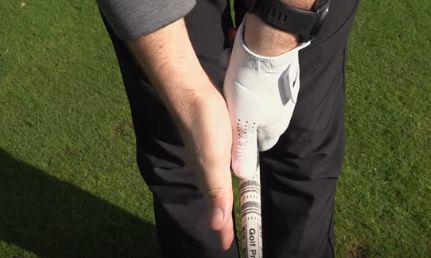
A Weak Grip
A weak grip for amateur golfers invariably results in a slice. When your trail hand V points at your chin or toward your lead shoulder and the palm of your hand faces toward you instead of your target, you are said to have a weak grip. Often, the lead hand is also rotated out too much such that your knuckles are pointing toward the ground, and its V is pointing at your chin, and at, or outside of the lead shoulder.

When you have had this position for some time it seems natural and our proprioception gets skewed. It’s relatively easy to recognise however.
When you look down at you lead hand ideally you should see at least two knuckles on that lead hand, or at the very least the logo on your golf glove (without having to crane your head around to see).
You can use the directions above on producing a neutral grip to correct a weak grip. A neutral grip may not be enough with your natural shot shape to square up your club face at impact. If a neutral grip is still producing a slice, unwanted fade, or a push to the right (for a righty), you may need to strengthen your grip.
A Strong Grip
A strong grip is clearly the opposite of a weak grip. It often produces a big hook, or a notable pull to the left (for a righty).
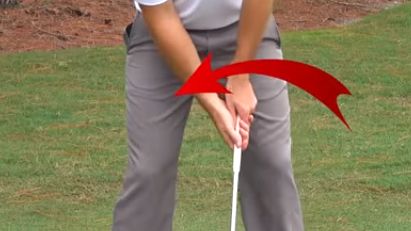
When you look down at your lead hand on the club you see more than two knuckles, and for a really strong grip, most of the back of your hand.
The V of your lead hand will point past / outside your trail shoulder. Your trail hand will be tucked under your club, such that the V made by your thumb and forefinger point away from or outside of your trail shoulder and body, and your palm faces away from you.
Again, you can correct this by learning the neutral grip position and working from there.
Note, that these positions can also be used to shape a shot for a specific outcome. But not in their own right. The grip will work in unison with the type of club, and importantly your follow through. Your follow through is a key determinant in the shape and direction of your shot also.
As well, if you have a good neutral grip but you hook or slice the ball you van modify your grip in the appropriate way as the ‘first port of call’ when trying to correct it.
The More relaxed, The better
Sometimes, when we are anxious about a shot, we can squeeze just that little bit too hard. Tension is insidious and before you know, it can creep up your arms and into your shoulders.
Unhappily, this can result in the overuse of certain muscles and the overall action of your swing is not as relaxed or effective. On a scale of 1-10, with 10 being the hardest you can comfortably grip, aim for a normal grip pressure of about 5 or 6.
As a general rule, a more relaxed grip will give you a faster club head speed on impact and you can look forward to enjoying those awesome long drives. It will stop you from casting the club too early and losing power that way too.

A Yoga Trick for You
You can more easily maintain a state of focused relaxation by taking long slow deep breaths as you set up. Breathe in and out through your nose with the tip of your tongue pressed against the roof of your mouth (a yoga trick). This automatically cultivates your body’s natural relaxation response and you will be surprised at how much greater ease you enjoy in your swing.
Good Wrist Action – is the automatic result of a good grip. Your wrists can move in two directions during the golf swing. Forward/ backward motion in the direction of the swing is known as “breaking”. “Hinging” refers to the upwards/downwards motion.
Your goal is to eliminate breaking at all costs and to naturally create the proper hinging action as a result of proper grip. It’s simple! If you ensure the back of your lead hand remains flat with respect to the back of your leading forearm, the proper hinging action will effortlessly and automatically result.
A Great Foundation
Your grip is your foundation to a great game of golf. So, remember to position your club correctly, cultivate a relaxed feel in your grip and enjoy the natural “chill” response from breathing properly.
Choose the grip type that’s right for you. Watch your Vs and enjoy effortlessly good wrist action. Remember, your game is all about fun and relaxation and with these simple pointers you can look forward to many days of enhanced driving pleasure and shots on the fairway.

